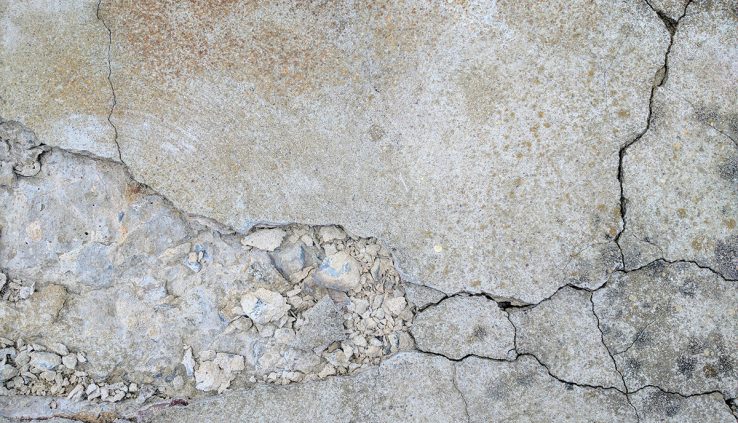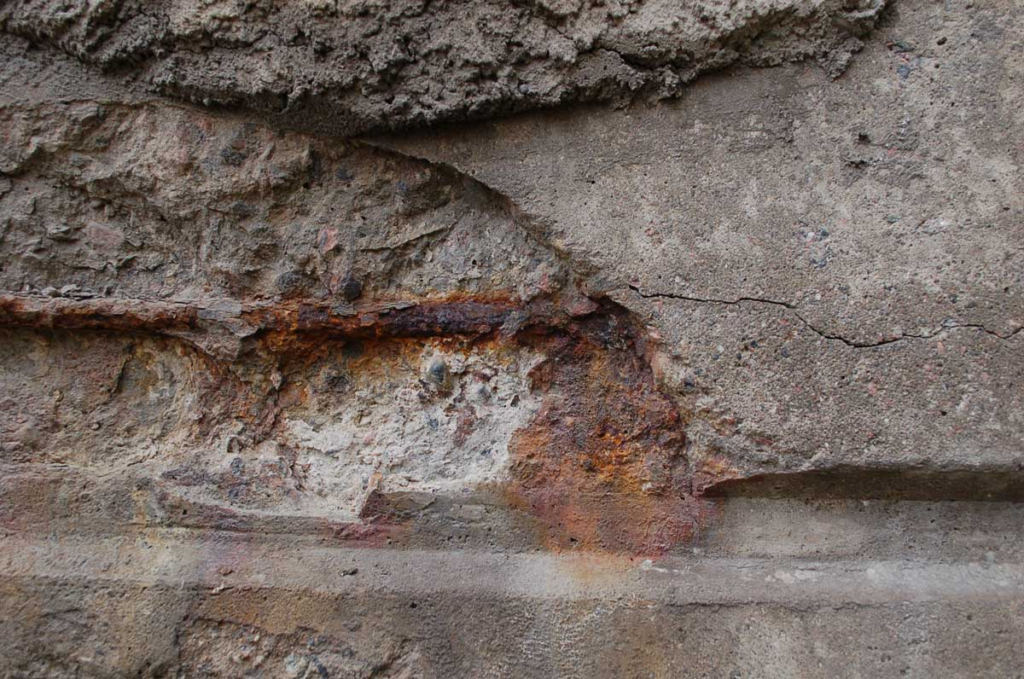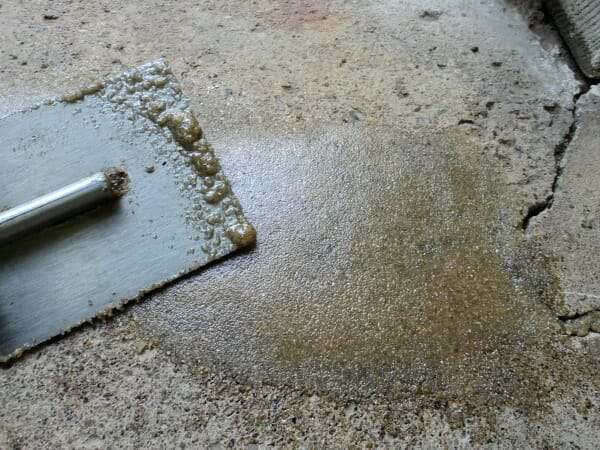Introduction to Spalling Concrete
Spalling concrete, also known as concrete flaking or scaling, is the breakdown of concrete surfaces due to various factors. This can result in a pitted or rough surface appearance, with chunks of concrete or small flecks falling off the surface, potentially exposing the rebar beneath.
In this comprehensive guide, we will discuss the causes of spalling concrete, its signs and symptoms, repair and prevention methods, and how to choose the right solution for your specific situation.

Causes of Spalling Concrete
Understanding the factors that contribute to spalling concrete is crucial for identifying the problem and implementing the right solution to help fix spalling concrete. Here, we delve deeper into these causes and provide more extensive information about each factor.
Moisture Penetration and Freeze-Thaw Cycles
Moisture penetration is a common cause of spalling concrete. When concrete freezes water seeps into the concrete, and it can cause the concrete to expand and contract as the water freezes and thaws.
This process is particularly detrimental in colder climates, where freeze-thaw cycles are frequent and more severe. To mitigate the effects of moisture penetration, proper drainage systems and water-resistant coatings can be used to reduce the amount of water that comes into contact with the concrete.
Chemical Exposure and Deterioration
Concrete is susceptible to breakdown when exposed to various chemicals, such as de-icing salts, fertilizers, and acids. These substances can weaken the concrete’s structural integrity, making it more prone to spalling.
To prevent chemical-induced spalling, it is essential to minimize the use of harmful chemicals on or near concrete surfaces. Additionally, protective coatings or sealants can be applied to create a barrier against chemical exposure, preserving the concrete’s strength and durability.
Inadequate Concrete Mix and Curing
A poor concrete mix, characterized by an incorrect water-to-cement ratio, inadequate air entrainment, or insufficient curing time, can result in weak concrete that is susceptible to spalling.
To avoid this issue, it is critical to follow industry-standard guidelines for mixing and curing concrete. This includes using the appropriate ratio of water to cement, ensuring sufficient air entrainment to allow for proper expansion and contraction, and allowing the concrete to cure for the recommended duration to achieve optimal strength and durability.
Corrosion of Reinforcing Steel (Rebar)
Corrosion of reinforcing steel, or rebar, within the concrete, can lead to cracking and eventually spalling. As the rebar corrodes, it expands, causing pressure on the surrounding concrete and leading to cracks and spalling.
Preventing rebar corrosion requires proper concrete cover thickness and using corrosion-resistant materials such as epoxy-coated rebar or stainless steel. Additionally, protective coatings and sealants can help minimize moisture and chemical exposure, which can contribute to corrosion.

Mechanical Damage and Wear
Heavy traffic, impact damage, or abrasive wear can all cause the concrete to break down and spall. Over time, this mechanical stress weakens the concrete’s structure, leading to spalling.
To minimize mechanical damage, it is important to design concrete surfaces with the appropriate thickness and reinforcement to withstand the anticipated loads and wear. Additionally, regular maintenance and inspection of concrete surfaces can help identify and address potential issues before they escalate into more severe spalling problems.
Signs and Symptoms of spalling concrete
Early identification of spalling concrete and foundation spalling is crucial for addressing the issue before it worsens and causes further damage. Here, we provide a more extensive and informative look at the common signs and symptoms of concrete spalling and foundation spalling:
Pitting or Scaling on foundation spalling
Pitting and scaling are early indicators of spalled concrete. Pitting refers to the formation of small cavities or depressions on foundation spalling, while scaling is the flaking or peeling away of the top layer of the concrete.
Both pitting and scaling can be caused by a combination of factors, such as moisture penetration, freeze-thaw cycles, or chemical exposure. Regular inspection of concrete foundation spalling can help identify these early signs of foundation spalling and allow for timely intervention.
Chunks of Concrete Falling Off
As spalling progresses, larger pieces of concrete may start to break off and fall from the concrete foundation. Not only that but concrete walls can spall and break off concrete.
This not only compromises the structural integrity of the concrete but also poses a potential safety hazard. If you notice chunks of concrete falling off, it is essential to assess the extent of the damage and implement appropriate repair measures to prevent further deterioration.

Exposed Rebar or Steel Reinforcement
In severe cases of spalled concrete, the rebar or steel reinforcement within the concrete may become exposed. This exposure accelerates the corrosion of the reinforcement and further weakens the concrete structure.
If you observe exposed rebar or steel reinforcement, it is crucial to consult with a structural engineer or qualified professional to determine the appropriate repair and reinforcement methods.

Cracking or Crumbling of the Concrete
Cracks or crumbling areas within the loose concrete are often signs of underlying spalling issues. These cracks may appear as hairline fractures or wider gaps, and they can indicate structural problems or potential moisture intrusion.
Regular monitoring of the concrete surface for cracks and prompt repair can help prevent further spalling and maintain the integrity of the concrete.
Discoloration or Staining
Discoloration or staining on the concrete surface can be indicative of moisture penetration, chemical exposure, or the presence of mold and mildew. These issues can weaken the concrete and contribute to spalling over time. Inspecting the concrete for any signs of discoloration or staining and addressing the underlying causes can help prevent further damage and maintain the appearance and functionality of the concrete surface.

Spalling Concrete Foundation Repair and Prevention Techniques
There are various methods available to spalling concrete foundation repair and prevent concrete spalling, depending on the severity and cause of the issue. Below, we provide a more in-depth and extensive look at these techniques to help you choose the most appropriate solution for spalling concrete foundation repair:
Patching for Minor Spalling Damage
Patching is a common method for repairing minor spalling damage. The process involves several steps:
- Remove the damaged concrete using a hammer and chisel, or a suitable power tool, to create a clean, sound edge around the affected area.
- Clean the area thoroughly, removing any loose debris, dust, or contaminants that could hinder the adhesion of the patching compound.
- Apply a bonding agent, if required, to enhance the bond between the existing concrete and the patching compound.
- Mix the patching compound as per the manufacturer’s instructions and apply it to the prepared area, ensuring it is well compacted and level with the surrounding surface.
- Allow the patch to cure according to the recommended time, and apply a sealer or protective coating if necessary to prevent future spalling.

Resurfacing for Extensive Damage
For more extensive damage, resurfacing may be necessary. This process involves:
- Removing the top layer of the damaged concrete using a grinder or shot blaster, exposing a solid and clean surface.
- Cleaning the surface to remove any loose debris, dust, or contaminants.
- Applying a bonding agent, if required, to ensure proper adhesion between the existing concrete and the new overlay.
- Mixing and applying a concrete overlay or resurfacing material according to the manufacturer’s instructions, ensuring a consistent and even finish.
- Curing the resurfaced area as per the recommended time, and applying a sealer or protective coating to protect against future spalling.
Protective Coatings for Prevention
Applying a protective coating, such as a sealer, epoxy, or polyurethane, can help prevent moisture penetration and protect the concrete from chemical exposure. These coatings create a barrier that shields the concrete from harmful elements, reducing the risk of foundation spalling.
When selecting a protective coating, consider factors such as the intended use of the concrete, the environment it is exposed to, and the specific protection required (e.g., water resistance, chemical resistance, or abrasion resistance).
Ensuring Proper Drainage
Proper drainage around your concrete is essential for preventing water accumulation and spalling. Some ways to ensure effective drainage include:
- Grading the soil to slope away from the concrete surface, preventing water from pooling.
- Installing drainage systems, such as French drains or catch basins, to collect and redirect excess water away from the concrete.
- Regularly inspecting and maintaining drainage systems to ensure they are functioning correctly and free from blockages or debris.
Controlling Chemical Exposure
Minimizing the use of de-icing salts, fertilizers, and other chemicals on or near your concrete can help prevent chemical damage and foundation spalling. Some measures to control chemical exposure include:
- Using alternative de-icing agents, such as sand or non-corrosive products, during winter months.
- Applying fertilizers carefully and avoiding direct contact with concrete surfaces.
- Regularly cleaning concrete surfaces to remove any chemical residues or spills.
- Educating occupants or users of the concrete surface about the potential risks of chemical exposure and the importance of proper care and maintenance.
Choosing the Right Repair and Prevention Method
To choose the most effective repair and prevention method for your concrete foundation spalling problem, consider the following factors:
- Severity of the damage: Assess the extent of the spalling and determine whether it is a localized issue or a more widespread problem. Minor spalling can be addressed with patching, while more extensive damage may require resurfacing or even replacement of the entire concrete structure.
- Underlying cause: Identify the primary cause of the spalling, whether it is moisture penetration, chemical exposure, inadequate concrete mix, rebar corrosion, or mechanical damage. Understanding the cause will help you select the most appropriate repair and prevention methods.
- Budget constraints: Consider the costs associated with different repair and prevention techniques and weigh them against the potential long-term benefits. While some methods may be more expensive upfront, they could save you money in the long run by preventing further damage or costly repairs.
- Aesthetics and functionality: Think about the appearance and function of the concrete surface and how these factors may influence your choice of repair and prevention methods. For example, a highly visible or frequently used surface may require a more aesthetically pleasing repair solution or a more durable protective coating.
- Professional advice: Consult with a structural engineer or a qualified concrete repair specialist to get expert guidance on the most suitable repair and prevention methods for your specific situation. These professionals can assess your concrete’s condition, identify the underlying causes of the spalling, and recommend the most effective solutions.
Conclusion
Concrete foundation spalling and concrete wall spalling can compromise the structural integrity, safety, and appearance of your concrete surfaces. Nobody wants their concrete to have a foundation spalling form. By understanding the causes and signs of spalling, you can identify the problem early and take appropriate action to prevent spalling and further damage to your new concrete and maximize fixing foundation spalling.
Various repair and prevention methods are available, including patching, resurfacing, protective coatings, proper drainage, and controlling chemical exposure. When choosing the right method, consider factors such as the severity of the damage, the underlying cause, budget constraints, aesthetics, functionality, and professional advice. Restore the stability of your pier and beam foundation with professional repair services. Our experts specialize in effective solutions tailored to your specific needs. Schedule your pier and beam foundation repair today!
By selecting the most appropriate repair and prevention techniques, you can effectively address your concrete spalling problem and maintain the durability and longevity of your concrete surfaces.